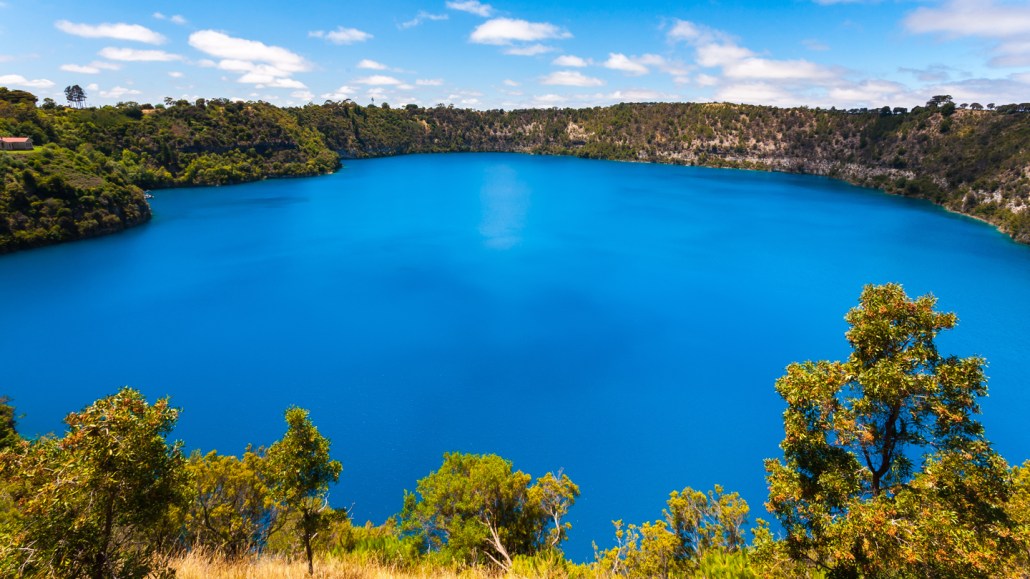Warming temps could turn some blue lakes green or brown
Such color shifts may signal changes in ecosystems and how lakes are used

Right now, about one-third of the world’s lakes are blue. Rising temperatures due to climate change could reduce that number.
ianwool/iStock/Getty Images Plus
Share this:
- Share via email (Opens in new window) Email
- Click to share on Facebook (Opens in new window) Facebook
- Click to share on X (Opens in new window) X
- Click to share on Pinterest (Opens in new window) Pinterest
- Click to share on Reddit (Opens in new window) Reddit
- Share to Google Classroom (Opens in new window) Google Classroom
- Click to print (Opens in new window) Print
In the future, kids may not reach for the blue crayon to draw a lake. Climate change could turn many now-blue lakes to green or brown.
Researchers have just completed the first worldwide tally of lake color. Roughly one-third of them are blue, they now estimate. But that number may drop if global temperatures rise. If average air temps in summer rose just a few degrees warmer, some of those crystal blue waters could turn a murky green or brown. The team shared its findings September 28 in Geophysical Research Letters.
Lake color reflects more than appearance. It offers clues to the stability of lake ecosystems. Factors such as water depth and how the nearby land is used also matter. Lake color depends in part, too, on what’s in the water. Compared with blue lakes, green or brown lakes have more algae, suspended sediment and organic matter. That’s according to Xiao Yang. A hydrologist, he works at Southern Methodist University in Dallas, Texas. Changing lake hues, he says, could also alter how people use those waters.
Yang was part of a team that analyzed the color of more than 85,000 lakes around the world. They used satellite photos from 2013 to 2020. Storms and seasons can temporarily affect a lake’s color. So the researchers focused on the most frequent color observed for each lake over the seven-year period. (You can explore the colors of these lakes, too. Try out the researchers’ interactive online map.)
The scientists then looked at local climates during the same time period. They wanted to see how climate might be linked to lake color. Finding such data are not as simple as looking up past weather reports. For many small or remote bodies of water, records of temperature and precipitation don’t exist. Here, the researchers used climate “hindcasts.” Those reports were pieced together from fairly sparse records for each spot on the globe.
Average summer air temperatures and lake color were linked, the researchers found. Lakes were more likely to be blue in places where summer temps averaged less than 19º Celsius (66º Fahrenheit).
Up to 14 percent of lakes that are blue were near that threshold, though. That means just a bit more warming might tip them away from blue. Scientists think the planet could average 3 degrees Celsius (about 6 degrees Fahrenheit) warmer by 2100. If so, that could turn another 3,800 lakes green or brown. Warmer water can boost algae growth, Yang says. That will give the water a green-brown tint.
What do color changes signal?
The approach used in this study is “super cool,” says Dina Leech. She did not take part in the study. An aquatic ecologist, Leech works at Longwood University in Farmville, Va. She finds the satellite data “just so powerful.”
Studying 85,000 lakes may sound like a lot. Still, it’s just a small share of all the world’s lakes. So it’s tricky to know how these results might apply everywhere, says Catherine O’Reilly. “We don’t even know how many lakes there are in the world,” notes this study coauthor. She’s an aquatic ecologist at Illinois State University in Normal. Many lakes are too small to reliably detect via satellites, she says. Even so, an estimated tens of thousands of larger lakes could lose their blue hue.
Lakes are often used for drinking water, food or recreation. If the water is more clogged with algae, it could be unappealing for play. Or it might cost more to clean it for drinking. As such, O’Reilly says, people might find less value in less-blue lakes.
In fact, the color changes might not mean the lakes are any less healthy. “[People] don’t value lots of algae in a lake,” O’Reilly notes. “But if you’re a certain type of fish species, you might be like ‘this is great!’”
Color also can hint at the stability of a lake’s ecosystem. A change in hue might signal shifting conditions for the critters that live there. One benefit of the new study is that it gives scientists a baseline for assessing how climate change is affecting Earth’s freshwater resources. Followup could help scientists detect changes as they emerge.
“[The study] sets a marker that we can compare future results to,” says Mike Pace. He’s an aquatic ecologist at the University of Virginia in Charlottesville. He says: “That’s, to me, the great power of this study.”






